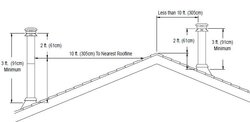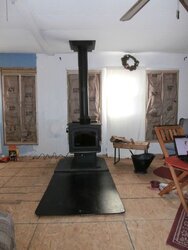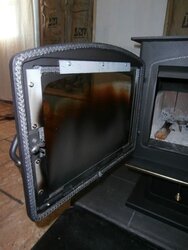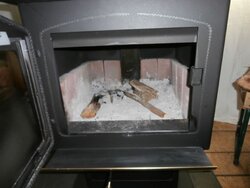As I wait for the Outside Air Kit and pipe and thermodisc and magnetic thermometer to place on the Drolet Myraid wood stove that I have had for three days now, ... I admit. I have wondered whether or not I have spent and wasted $1,000 on this new stove. I don't believe such a statement 100% but I have thought this several times in the past 72 hours.
The stove is not "heating" as impressively as I had imagined it would. The rooms I'm in run about 30' across by 50' with a wooden divide in the middle of living room, dining room, laundry room and kitchen.
The house is about 1500 square foot (double-wide home) on a quarter acre. This is my first NEW stove and bought it primarily based on the very positive reviews I've read from several different websites.
Well, by the 2nd day, the glass had turned nearly 3/4 reddish black. Only the upper top of it was still clear. The stove makes a pinging sound that I think is normal and probably when the metal is expanding and contracting with the heat. I never did smell that new wood stove odor and why you must first make your small fires so the paint will cure, and then you can burn with larger wood pieces.
My guess is the problem is my wood and it is about one year old. I'm having doubts now that it may not be as "seasoned" by now as I thought it was.
I need to get a hardwood like Oak. Instead I am using left over wood such as hickory, walnut and something else but I don't know the name of it. My other guess is that if the "peak" of the roof is considered the upside-down "V" part that brings the two sides of a double-wide house together, then I can tell you that the triple-wall Duravent chimney pipe is NOT past that on the roof and I think I should have my friend put up another two or three feet of pipe. He insists on measuring it first next week and says why should I pay for three feet if I really only need two? I guess he is right and so that's what we'll do.
I am even a little jealous when I read that owners of the Myraid say neat things like their Myraid is really cranking out the heat ... but I think that they are using the good hardwoods, too, and perhaps have taller chimneys than mine.
Yesterday, and without sounding dramatic about it, ... I started feeling really sick in the living room and immediately closed the primary air control, exiting for the back bedroom that was cool and had no smoke smell or heat in it. I think it is a combination of the stove sucking the air that is in this house (it is not air-tight like some of the newer homes are), but at the same time, with the one year old wood pieces I get from the garage, ... that it is the bad particles of carbon dioxide that I'm breathing in ... so, yeah, I can't wait to receive the air kit in a week to a week and a half. I just laid down for a good hour before I felt better and went back into the living room.
Today I started using more of the hickory and less of the dark walnut. The walnut gives off so much smoke inside the stove that I just thought that the light colored hickory might be better to use for now, that maybe it is actually truly seasoned? I got both of these woods from two different people during summer 2013.
I've got double-wall stovepipe.
I don't understand how the pipe itself can be so hot to touch for more than a second last night and yet if I walk out from this living room into the kitchen on the other end of the room, you really can't feel any heat there. Am I expecting too much from this stove? Perhaps I am, but, after reading about larger houses that have been kept warm with their same stove as mine, I figure it has got to be what I've mentioned above and relatively easy to solve.
Yesterday morning, I had my coat on over my bathrobe BECAUSE it was not warm enough to
not have the coat on WHILE the stove was running. Honestly, I try to be a smart consumer but there's no way I had intended to pay a thousand bucks for a heater that only heats up three feet around the stove, ... so, I am not blaming the stove directly but I am frustrated and somewhat disappointed that I am not experiencing all that I had anticipated from a "new" stove by Drolet.
The weather today outside was warmer than yesterday but I've kept the stove going all day with a little bit of wood and I did not want to start a fire tonight from a cold stove.
I know that I'll feel better when my friend determines how much more pipe I need on the roof, ... whether I should buy a 1/2 cord of seasoned oak AFTER I buy a wood moisture meter and perhaps even if I should buy an Eco-fan, instead of using the blower. The Owner's Manual does say to turn it on one hour after you first light the stove. Cold air comes out of it but I guess it's suppose to. Initially I thought it was suppose to be warm air.
My friend also suggested I start small when starting the stove in the morning (oh, there have been some red coals in the morning, just not tons and tons of them); i.e., paper, kindling, small pieces of wood and then WAIT with the door cracked open an inch until that's all going gang-busters and THEN add a bigger piece of wood. I admit I get impatient and will put on a big log too soon (after .20 minutes), and then in a few minutes, nothing is happening. It won't burn and I realize that I've pushed my luck and have gone 2 steps back instead of getting that darn fire going strong.
Specifics: From floor to ceiling, it is 8 feet total, then into the 24 inch triple wall box and probably (for a total of 5 feet (?) triple wall pipe,) but as I mentioned before, ... I think it needs more as it sits under the highest peak of the roof ridge and that is certainly within 10 feet of where the chimney cap is located.
Well, I think I've given enough information so whomever responds can give me ideas or advice that I can try. Or, something I have not thought of. I've learned alot reading from hearth.com and looking at youtube.com, etc., so I think I know what's wrong but I could be wrong and the wood I have is fine and maybe it is just a pipe issue. I'll see what you all can share and I'd especially like to hear from any Myriad owners out there!
The stove is not "heating" as impressively as I had imagined it would. The rooms I'm in run about 30' across by 50' with a wooden divide in the middle of living room, dining room, laundry room and kitchen.
The house is about 1500 square foot (double-wide home) on a quarter acre. This is my first NEW stove and bought it primarily based on the very positive reviews I've read from several different websites.
Well, by the 2nd day, the glass had turned nearly 3/4 reddish black. Only the upper top of it was still clear. The stove makes a pinging sound that I think is normal and probably when the metal is expanding and contracting with the heat. I never did smell that new wood stove odor and why you must first make your small fires so the paint will cure, and then you can burn with larger wood pieces.
My guess is the problem is my wood and it is about one year old. I'm having doubts now that it may not be as "seasoned" by now as I thought it was.
I need to get a hardwood like Oak. Instead I am using left over wood such as hickory, walnut and something else but I don't know the name of it. My other guess is that if the "peak" of the roof is considered the upside-down "V" part that brings the two sides of a double-wide house together, then I can tell you that the triple-wall Duravent chimney pipe is NOT past that on the roof and I think I should have my friend put up another two or three feet of pipe. He insists on measuring it first next week and says why should I pay for three feet if I really only need two? I guess he is right and so that's what we'll do.
I am even a little jealous when I read that owners of the Myraid say neat things like their Myraid is really cranking out the heat ... but I think that they are using the good hardwoods, too, and perhaps have taller chimneys than mine.
Yesterday, and without sounding dramatic about it, ... I started feeling really sick in the living room and immediately closed the primary air control, exiting for the back bedroom that was cool and had no smoke smell or heat in it. I think it is a combination of the stove sucking the air that is in this house (it is not air-tight like some of the newer homes are), but at the same time, with the one year old wood pieces I get from the garage, ... that it is the bad particles of carbon dioxide that I'm breathing in ... so, yeah, I can't wait to receive the air kit in a week to a week and a half. I just laid down for a good hour before I felt better and went back into the living room.
Today I started using more of the hickory and less of the dark walnut. The walnut gives off so much smoke inside the stove that I just thought that the light colored hickory might be better to use for now, that maybe it is actually truly seasoned? I got both of these woods from two different people during summer 2013.
I've got double-wall stovepipe.
I don't understand how the pipe itself can be so hot to touch for more than a second last night and yet if I walk out from this living room into the kitchen on the other end of the room, you really can't feel any heat there. Am I expecting too much from this stove? Perhaps I am, but, after reading about larger houses that have been kept warm with their same stove as mine, I figure it has got to be what I've mentioned above and relatively easy to solve.
Yesterday morning, I had my coat on over my bathrobe BECAUSE it was not warm enough to
not have the coat on WHILE the stove was running. Honestly, I try to be a smart consumer but there's no way I had intended to pay a thousand bucks for a heater that only heats up three feet around the stove, ... so, I am not blaming the stove directly but I am frustrated and somewhat disappointed that I am not experiencing all that I had anticipated from a "new" stove by Drolet.
The weather today outside was warmer than yesterday but I've kept the stove going all day with a little bit of wood and I did not want to start a fire tonight from a cold stove.
I know that I'll feel better when my friend determines how much more pipe I need on the roof, ... whether I should buy a 1/2 cord of seasoned oak AFTER I buy a wood moisture meter and perhaps even if I should buy an Eco-fan, instead of using the blower. The Owner's Manual does say to turn it on one hour after you first light the stove. Cold air comes out of it but I guess it's suppose to. Initially I thought it was suppose to be warm air.
My friend also suggested I start small when starting the stove in the morning (oh, there have been some red coals in the morning, just not tons and tons of them); i.e., paper, kindling, small pieces of wood and then WAIT with the door cracked open an inch until that's all going gang-busters and THEN add a bigger piece of wood. I admit I get impatient and will put on a big log too soon (after .20 minutes), and then in a few minutes, nothing is happening. It won't burn and I realize that I've pushed my luck and have gone 2 steps back instead of getting that darn fire going strong.
Specifics: From floor to ceiling, it is 8 feet total, then into the 24 inch triple wall box and probably (for a total of 5 feet (?) triple wall pipe,) but as I mentioned before, ... I think it needs more as it sits under the highest peak of the roof ridge and that is certainly within 10 feet of where the chimney cap is located.
Well, I think I've given enough information so whomever responds can give me ideas or advice that I can try. Or, something I have not thought of. I've learned alot reading from hearth.com and looking at youtube.com, etc., so I think I know what's wrong but I could be wrong and the wood I have is fine and maybe it is just a pipe issue. I'll see what you all can share and I'd especially like to hear from any Myriad owners out there!






